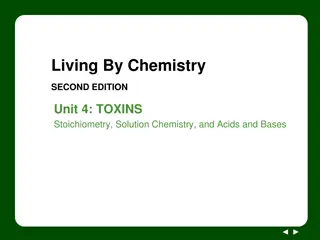Understanding pH Calculations for Acids and Bases in Water
Acids and bases play crucial roles in chemical reactions by involving the transfer of protons. This lecture explains the definitions of acids and bases, general acid-base reactions in water, and how the pH scale is used to measure the acidity or basicity of a solution. It covers how acids and bases affect the concentrations of H+ and OH- ions, leading to different pH values. Additionally, it provides examples of calculating the pH of various acids and bases in solution.
Download Presentation

Please find below an Image/Link to download the presentation.
The content on the website is provided AS IS for your information and personal use only. It may not be sold, licensed, or shared on other websites without obtaining consent from the author. Download presentation by click this link. If you encounter any issues during the download, it is possible that the publisher has removed the file from their server.
E N D
Presentation Transcript
Lecture 3 Calculating the pH of an Acid or Base in Water
Definitions of Acids and Bases (p. 80) Acid-base reactions are called proton transfer reactions. In a chemical reaction, H+is the symbol for a proton. So acid-base reactions are ones that involve the transfer of a proton (H+) from one species to another. Acid = proton (H+) donor; simple acid = HA Base = proton (H+) acceptor; simple base = B
Acids and Bases in Water (p. 80) General Acid Reaction in Water (Kareaction): HA(aq) + H2O(l) ] ][A O [H K a = A-(aq) + H3O+(aq) + - 3 [HA] General Base Reaction in Water (Kbreaction): B(aq) + H2O(l) BH+(aq) + OH-(aq) + - [BH = ][OH ] K b [B]
Figure 14.6: The pH Scale and pH Values of Some Common Substances p. 84 H+(aq) + OH-(aq) H2O(l) Kw = [H+][OH-] = 1.0 x 10-14 pH = -log[H+] pOH = -log[OH-] pH + pOH = 14.00
Figure 14.6: The pH Scale and pH Values of Some Common Substances p. 84 H+(aq) + OH-(aq) H2O(l) Kw = [H+][OH-] = 1.0 x 10-14 pH = -log[H+] pOH = -log[OH-] pH + pOH = 14.00 Acids add H+ to water. An acidic solution has: large [H+], so small [OH-] low pH, so high pOH
Figure 14.6: The pH Scale and pH Values of Some Common Substances p. 84 H+(aq) + OH-(aq) H2O(l) Kw = [H+][OH-] = 1.0 x 10-14 Bases add OH- to water. A basic solution has: large [OH-], so small [H+] low pOH, so high pH pH = -log[H+] pOH = -log[OH-] pH + pOH = 14.00 Acids add H+ to water. An acidic solution has: large [H+], so small [OH-] low pH, so high pOH
Calculating pH of Acids or Bases (p. 88) A. Calculate the pH of 0.10 M HCl. B. Calculate the pH of 0.10 M HC2H3O2. C. Calculate the pH of 0.10 M NH3. D. Calculate the pH of 0.10 M NaOH.
Values for Ka for Some Common Monoprotic Acids p. 81 Example Ka reaction for HNO2, Ka = 4.0 x 10-4: HNO2(aq) + H2O(l) or: HNO2(aq) H3O+(aq) + NO2-(aq) H+(aq) + NO2-(aq)
Values for Kb for Some Common Weak Bases p. 81 Example Kb reaction for C5H5N, Kb = 1.7 x 10-9: C5H5N(aq) + H2O(l) OH-(aq) + C5H5NH+(aq)
Calculating pH of Acids or Bases (p. 88) A. Calculate the pH of 0.10 M HCl. HCl is a strong acid to memorize. B. Calculate the pH of 0.10 M HC2H3O2. HC2H3O2 is a weak acid (Ka = 1.8 x 10-5). C. Calculate the pH of 0.10 M NH3. NH3 is a weak base (Kb = 1.8 x 10-5). D. Calculate the pH of 0.10 M NaOH. NaOH is a strong base to memorize.
Calculating pH of Acids or Bases (p. 88) pH = -log[H+] A. Calculate the pH of 0.10 M HCl. HCl is a strong acid to memorize. B. Calculate the pH of 0.10 M HC2H3O2. HC2H3O2 is a weak acid (Ka = 1.8 x 10-5). C. Calculate the pH of 0.10 M NH3. NH3 is a weak base (Kb = 1.8 x 10-5). D. Calculate the pH of 0.10 M NaOH. NaOH is a strong base to memorize.
Figure 14.4: (a) Strong Acid HA Ionized in Water; (B) Weak Acid HB Ka reaction: H3O+(aq) + X-(aq) H+(aq) + X-(aq) HX(aq) + H2O(l) or: HX(aq)
Calculating pH of Acids or Bases A. Calculate the pH of 0.10 M HCl. pH = 1.00 HCl is a strong acid to memorize. B. Calculate the pH of 0.10 M HC2H3O2. pH=2.87 HC2H3O2 is a weak acid (Ka = 1.8 x 10-5). C. Calculate the pH of 0.10 M NH3. pH = 11.13 NH3 is a weak base (Kb = 1.8 x 10-5). D. Calculate the pH of 0.10 M NaOH. pH = 13.00 NaOH is a strong base to memorize.
Variation of a weak acid problem-p. 89 A 3.00 M weak acid (HX) solution is 20.% dissociated to reach equilibrium. What is the equilibrium concentration of HX in this solution? % dissociation or % ionization = percent acid reacted = x 100 [HA] 0 Calculate the Ka value for HX.
Variation of a weak base problem (p. 89, #2) The pH of s 1.0 10 3 M solution of pyrrolidine is 10.82. Calculate Kb for pyrrolidine (C4H9N).
Variation of a weak base problem (p. 89, #2) The pH of s 1.0 10 3 M solution of pyrrolidine is 10.82. Calculate Kb for pyrrolidine (C4H9N). How solve?
Variation of a weak base problem (p. 89, #2) The pH of s 1.0 10 3 M solution of pyrrolidine is 10.82. Calculate Kb for pyrrolidine (C4H9N). How solve? Set up ICE table using the Kb reaction for the weak base pyrrolidine. See p. 89.5 for solution.
Conjugate Acid-Base Pairs (p. 83) Pairs of substances that only differ by a proton (H+) in their formulas are called conjugate acid-base pairs. Examples of acid-conjugate base pairs: HBr and Br- HC2H3O2 and C2H3O2- HOCl and OCl- Examples of base-conjugate acid pairs: NH3 and NH4+ HONH2 and HONH3+
Conjugate Acid-Base Pairs (p. 83) -As the name indicates, one species in a conjugate acid-base pair behaves as an acid (H+ donor), while the other species in the pair behaves as a base (H+ acceptor). -To determine how good an acid or base something is, you need to determine the Ka or Kb value. -For all conjugate acid-base pairs: Ka x Kb = Kw (At 25oC, Kw = 1.0 x 10-14) -See p. 85 of Handouts packet for a derivation of this formula.
Using Ka x Kb = Kw = 1.0 x 10-14 (p. 83) For HNO2, Ka = 4.0 x 10-4 and the conjugate base is NO2- . What type of base is NO2-?
Using Ka x Kb = Kw = 1.0 x 10-14 (p. 83) For HNO2, Ka = 4.0 x 10-4 and the conjugate base is NO2- . What type of base is NO2-? Need to calculate Kb for NO2-. NO2-(aq)+ H2O(l) HNO2(aq) + OH-(aq) Kb=?
Using Ka x Kb = Kw = 1.0 x 10-14 (p. 83) For HNO2, Ka = 4.0 x 10-4 and the conjugate base is NO2- . What type of base is NO2-? NO2-(aq)+ H2O(l) HNO2(aq) + OH-(aq) Kb=? For all conjugate acid-base pairs: Ka x Kb = Kw (At 25oC, Kw = 1.0 x 10-14)
Using Ka x Kb = Kw = 1.0 x 10-14 (p. 83) For HNO2, Ka = 4.0 x 10-4 and the conjugate base is NO2- . What type of base is NO2-? NO2-(aq)+ H2O(l) HNO2(aq) + OH-(aq) Kb=? For all conjugate acid-base pairs: Ka x Kb = Kw (At 25oC, Kw = 1.0 x 10-14) Kb for NO2- = Kw/Ka for HNO2
Using Ka x Kb = Kw = 1.0 x 10-14 (p. 83) For HNO2, Ka = 4.0 x 10-4 and the conjugate base is NO2- . What type of base is NO2-? NO2-(aq)+ H2O(l) Kb for NO2- = Kw/Ka for HNO2 HNO2(aq) + OH-(aq) Kb=? 14 - 10 1.0 = - 11 - 2.5 = 10 K (NO a is weak base.) b 2 4 - 10 4.0
Using Ka x Kb = Kw = 1.0 x 10-14 (p. 83) For HCl, Ka 1 x 106 and the conjugate base is Cl-. What type of base is Cl-?
Using Ka x Kb = Kw = 1.0 x 10-14 (p. 83) For HCl, Ka 1 x 106 and the conjugate base is Cl-. What type of base is Cl-? Need to calculate Kb for Cl-.
Using Ka x Kb = Kw = 1.0 x 10-14 (p. 83) For HCl, Ka 1 x 106 and the conjugate base is Cl-. What type of base is Cl-? Need to calculate Kb for Cl-. For conjugate acid-base pairs, Ka x Kb = Kw.
Using Ka x Kb = Kw = 1.0 x 10-14 (p. 83) For HCl, Ka 1 x 106 and the conjugate base is Cl-. What type of base is Cl-? Kb for Cl- = Kw/Ka for HCl 10 1.0 K 6 b 14 - - 20 = 1 = x 10 (a very tiny number) 1 10
Using Ka x Kb = Kw = 1.0 x 10-14 (p. 83) For HCl, Ka 1 x 106 and the conjugate base is Cl-. What type of base is Cl-? Kb for Cl- = Kw/Ka for HCl 10 1.0 K 6 b 14 - - 20 = 1 = x 10 (a very tiny number) 1 10 We call Cl- a worthless base because Kb << Kw = 1.0 x 10-14.
Using Ka x Kb = Kw = 1.0 x 10-14 (p. 83) For NH3, Kb = 1.8 x 10-5 and the conjugate acid is NH4+ . What type of acid is NH4+?
Using Ka x Kb = Kw = 1.0 x 10-14 (p. 83) For NH3, Kb = 1.8 x 10-5 and the conjugate acid is NH4+ . What type of acid is NH4+? Need to calculate Ka for NH4+.
Using Ka x Kb = Kw = 1.0 x 10-14 (p. 83) For NH3, Kb = 1.8 x 10-5 and the conjugate acid is NH4+ . What type of acid is NH4+? Need to calculate Ka for NH4+. NH4+(aq) NH3(aq)+ H+(aq) Ka = ?
Using Ka x Kb = Kw = 1.0 x 10-14 (p. 83) For NH3, Kb = 1.8 x 10-5 and the conjugate acid is NH4+ . What type of acid is NH4+? Need to calculate Ka for NH4+. NH4+(aq) NH3(aq)+ H+(aq) Ka = ? Ka x Kb = Kw, so Ka for NH4+ = Kw/Kb for NH3.
Using Ka x Kb = Kw = 1.0 x 10-14 (p. 83) For NH3, Kb = 1.8 x 10-5 and the conjugate acid is NH4+ . What type of acid is NH4+? Need to calculate Ka for NH4+. NH4+(aq) NH3(aq)+ H+(aq) Ka = ? Ka x Kb = Kw, so Ka for NH4+ = Kw/Kb for NH3. 10 5.6 10 1.8 14 - 10 1.0 = + 10 - = K (NH a is weak acid.) a 4 5 -
Using Ka x Kb = Kw = 1.0 x 10-14 (p. 83) For NH3, Kb = 1.8 x 10-5 and the conjugate acid is NH4+ . What type of acid is NH4+? Ka for NH4+ = Kw/Kb for NH3 10 1.0 K a 14 - + 10 - = 5.6 = 10 (NH a is weak acid.) 4 5 - 1.8 10 One of my favorite sayings with acid-base chemistry is that weak gives you weak, and strong gives you garbage. What does this saying refer to?
Using Ka x Kb = Kw = 1.0 x 10-14 (p. 83) For NH3, Kb = 1.8 x 10-5 and the conjugate acid is NH4+ . What type of acid is NH4+? Ka for NH4+ = Kw/Kb for NH3 10 1.0 K 5 - a = 14 - + 10 - = 5.6 10 (NH a is weak acid.) 4 1.8 10 One of my favorite sayings with acid-base chemistry is that weak gives you weak, and strong gives you garbage. How about the stronger the acid, the weaker the conjugate base?
Lecture Question on Conjugate Acids and Conjugate Bases-p. 87.5 Consider the Ka and Kb values given on p. 87.5. Which of the following statements is false? a. The pH of a 1.0 M NaCl solution will be 7.00. b. CN- is a weak base. c. C6H5NH3+ is a weak acid. d. A 1.0 M solution of NO2- will have a higher pH than a 1.0 M solution of CN-. e. A 1.0 M solution of C6H5NH3+ will have a lower pH than a 1.0 M solution of NH4+ .
Lecture Question on Conjugate Acids and Conjugate Bases Consider the Ka and Kb values given on p. 87.5. Which of the following statements is false? a. The pH of a 1.0 M NaCl solution will be 7.00. b. CN- is a weak base. c. C6H5NH3+ is a weak acid. d. A 1.0 M solution of NO2- will have a higher pH than a 1.0 M solution of CN-. e. A 1.0 M solution of C6H5NH3+ will have a lower pH than a 1.0 M solution of NH4+ .
Lecture Question (p. 89, #1) A 3.00 M weak acid (HX) solution is 20.% dissociated to reach equilibrium. What is the equilibrium concentration of HX in this solution? % dissociation or % ionization = percent acid reacted = x 100 [HA] a. 0.60 b. 2.20 M c. 2.40 M d. 2.80 M e. 3.00 M
Lecture Question (p. 89, #1) A 3.00 M weak acid (HX) solution is 20.% dissociated to reach equilibrium. What is the equilibrium concentration of HX in this solution? % dissociation or % ionization = percent acid reacted = x 100 [HA] a. 0.60 b. 2.20 M c. 2.40 M d. 2.80 M e. 3.00 M























